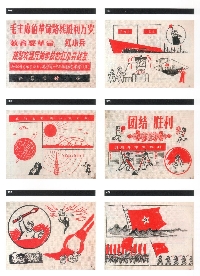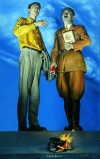
Illustration:
ill. 5.9
Date:
1967
Genre:
manual, instruction book, illustration
Material:
scan, paper, colour; original source: paper, colour
Source:
Heller 2008: Heller, Steven. Iron Fists: Branding the 20th Century Totalitarian State. New York: Phaidon, 2008:200/201.
Keywords:
Little Red Book, Red Guards, Mao portrait, Mao´s portrait, Cultural Revolution, Cultural Revolution styles, red sun, sunrays, sunflower, red, bright and shining, lofty, grand and complete, revolutionary realism, Revolutionary Romanticism, soldiers, children
Model Book for Creating Cultural Revolution Propaganda Images
Mao appears, in all of these depictions, in one and the same pose and character, as “red, bright and shining” 红光亮in accordance with conventions that would be perpetuated through model books as seen here, which taught both laymen and professionals how (not) to paint (Andrews 1994:321ff.). Accordingly, Mao stands out prominently, he is a stately figure, “lofty, grand and complete” 高大全, another threesome from the toolbox of Revolutionary Realism and Revolutionary Romanticism (cf. Yan 2008:98): he stands with straight back and fixed gaze, calm and confident, always in a state of being rather than becoming, typical in totalitarian art generally—either among a group, of peasants for example (ill. 5.7 and ill. 5.8), among a crowd of young demonstrators, military or party members (ill. 5.4 and ill. 5.5) or in surrounding nature (ill. 5.1, ill. 5.2, ill. 5.3) all of which are in the state of becoming, moving.
His gestures suggest confidence and determination: his hand may form a fist (ill. 5.1 and ill. 5.7), it may be raised high up into the skies (ill. 5.4 and ill. 5.6), it may be folded leisurely or propped into his waist (ill. 5.3, ill. 5.5), or holding some significant and symbolic objects: the fruit whose growth he supports as the Chinese sun, for example, and the book with which he instructs his “children” in Yan’an (ill. 5.7, ill. 5.8). Mao looks either out of the picture, into the viewer’s face or, with his eyes slightly raised, into the grand and glorious future. Thus, all of these images convey the same message, they depict one and the same Mao: Mao as superlative—the biggest and the greatest—Mao, the most important leader of the Chinese revolution who knows how and where to direct his country, always and for everyone. These pictures appeal to their implied audience to believe in and trust this bright and brilliant, strong and sturdy Mao.












































































































